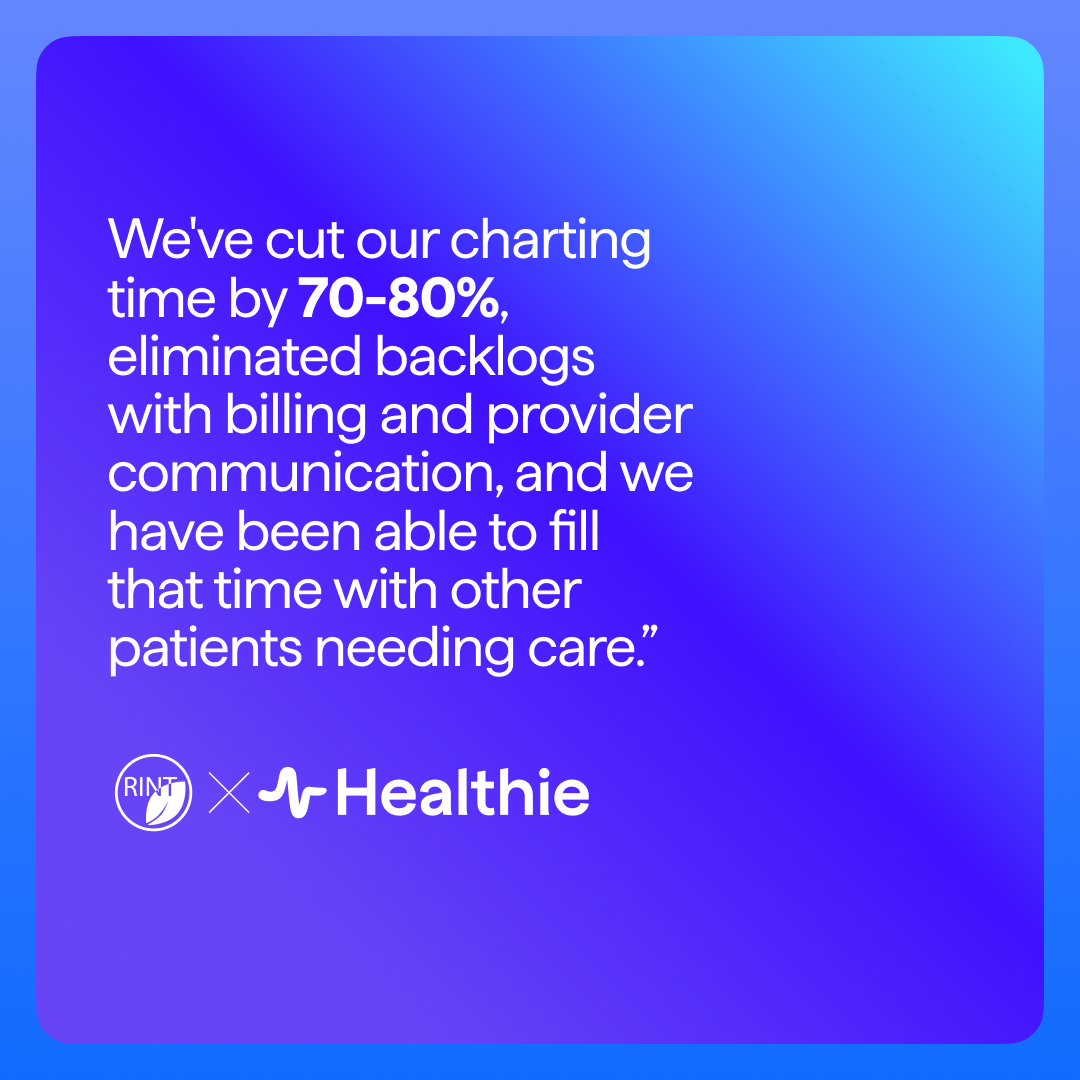

Insurance billing for telenutrition sessions
Learn how to bill insurance for telenutrition sessions in our guide. Discover telehealth billing tips and requirements with Healthie.
Quality telehealth care has been shown to improve health care access and outcomes, particularly for chronic disease treatment and for vulnerable groups. Not only does telehealth reduce demands on crowded facilities, but it also creates cost savings and makes the health sector more resilient.
The large insurance payers, including BCBS, United Healthcare, Cigna, Aetna, Humana, and Medicare all offer some form of coverage for telehealth services. However, despite the overwhelming benefits to providing telehealth care, insurance reimbursement and legislation in the United States is still in the nascent stage. Telehealth and telenutrition are typically still listed as a “policy-dependent” medical service, resulting in reimbursement that tends to vary from client-to-client, even if they have the same insurance provider.
Furthermore, while insurance reimbursement for telemedicine services provided by doctors has seen great improvements in recent years, reimbursement for telenutrition services is still lagging.
In this article, we help you learn the basics for insurance billing for telehealth nutrition services and telehealth reimbursement.
These recommendations can only serve as general guidelines, as each insurance payer and each state have different requirements regarding telehealth services. We suggest you review the recommendations outlined below, and then reach out to each insurance payer you are credentialed with to verify telehealth billing requirements and procedures for telenutrition billing.
Healthie’s comprehensive practice management software can help your practice navigate this process with EHR and insurance billing features. Our Free Starter Plan makes it seamless to chart on clients and create insurance claims.
{{free-trial-signup}}
Legal requirements for providing telehealth nutrition services
Currently 47 states, Puerto Rico and the District of Columbia have statutory provisions regulating the dietetics profession or associated titles such as “dietitian” and “nutritionist”. In most states, this means that there is either licensure or certification that one must obtain through your State Board in order to be legally credentialed.
Telehealth in the United States is currently affected by laws and regulations at the federal and state levels. In short, this means that telehealth laws, regulations, and reimbursements are determined by each state government — making it impossible to have a “uniform” telehealth policy. In addition, some states specifically restrict practice to providers who hold a state-issued telehealth certificate or other similar permissions, although this primarily refers to physicians.
What you ultimately need to understand about legally providing medical telenutrition therapy services, is that you must abide by state regulations in the state where your client resides. Even if you are a licensed registered dietitian in your state, you may not be able to counsel a client who resides in a different state, if their state has strict licensure for nutrition professionals.
Learn more about state legislations for telehealth in our comprehensive Guide: Telehealth Basics for Nutrition Professionals
What insurance payers may require from nutrition professionals
In addition to following state regulations, each insurance payer may have their own requirements for nutrition professionals to receive their telehealth reimbursement. Understanding these nuances for each insurance payer will help you know whether you will ultimately be reimbursed for telenutrition care.
Here is a list of some insurance payer requirements for telehealth billing:
- Eligibility may be based on your state for nation-wide insurance providers
- How they define telehealth services (ie. phone call and/or video chat)
- Up-to-date professional liability insurance that covers for telehealth
- Utilizing HIPAA-compliant telehealth technology, or even a specific telehealth technology that has been approved by the insurance payer (typically a telemedicine platform used by doctors)
- Client diagnosis may be a factor
- Initial consultation may need to be provided in-person first, with subsequent follow-up sessions approved for telehealth
- Location site from where the nutrition professional provided the telehealth services (ie. from within a physician’s office)
Healthie’s free Starter plan is 100% HIPAA- & PCI compliant. Simply click here to sign up for a free account today.
To best know what an insurance payer will require for telehealth billing, you’ll want to review your contract carefully and clarify directly with an insurance representative. If you are in-network with multiple insurance providers, take notes diligently. You’ll want to document the telehealth requirements by the insurance payer, including the date that you were provided this information. Telehealth laws, and insurance regulations are constantly evolving. It would be in best practice to make a call annually to each provider to verify if there have been any changes to their telehealth requirements.
Knowing important telehealth terminology
Asynchronous Telecommunication:
Medical information is stored and forwarded to be reviewed at a later time by a physician or health care practitioner at a Distant Site. The medical information is reviewed without the patient being present. Also referred to as store-and- forward Telehealth or non-interactive telecommunication.
Distant Site:
The location of a Physician or Other Qualified Health Care Professional at the time the service being furnished via a telecommunications system occurs.
Originating Site:
The location of a telenutrition patient at the time the service being furnished via a telecommunications system occurs.
Telehealth:
Telehealth services are live, interactive audio and visual transmissions of a physician-patient encounter from one site to another using telecommunications technology. They may include transmissions of real-time telecommunications or those transmitted by store-and-forward technology.
Verifying if your client has telehealth benefits
Before providing telehealth care to a client, it’s best practice to call their insurance payer and verify that they are covered for telehealth services under their plan. Even if you have two clients with BCBS, their telehealth coverage may differ.
Verify benefits with the insurance representative, and be sure to document the reference number for your call. In the case that you were told your client does have telehealth benefits but your claim is later declined, you can provide your reference number. You’ll also want to call again each new benefits year to see if there have been changes in your client’s benefits, including nutritional care and telehealth eligibility.
Submitting CMS1500 claims for telehealth nutrition services
Billing for telehealth nutrition services may vary based on the insurance provider. When creating your insurance claim, most providers will accept your typical CPT codes submitted (ie. 97802, 97803, 97804) but require you to change the Place of Service Code to 02 for telehealth.
Image above shows how to select the “Place of Service Code” when completing a CMS 1500 claim within Healthie, a practice management platform for nutrition professionals. Learn more about creating insurance claims through Healthie’s Free Starter Plan here.
As of 2018, instead of using a modifier, you will indicate your services were rendered through telehealth using the place of service code. You should now use 02 – Telehealth for when “health services and health related services are provided or received, through telecommunication technology.”
Some other insurance payers, such as AETNA, may require you to also include a modifier code in your CMS 1500 claim when billing for telehealth. The two most commonly used modifiers for telehealth are:
- GQ – Asynchronous Telecommunications systems, such as a pre-recorded video
- GT – Interactive Audio and Video Telecommunications systems, including a live video conferencing session
- G0 – Telehealth services for diagnosis, evaluation, or treatment, of symptoms of an acute stroke
- 95 – Synchronous Telemedicine Service Rendered Via a Real-Time Interactive Audio and Video Telecommunications system
For telenutrition professionals, it is best practice to use modifier code 95, as it was specifically created for Medical Nutrition Therapy (MNT) codes (97802, 89703, 97804). While modified code GT has essentially the same function, it was created for more general medical services. As a provider offering nutrition services, you are more likely to be reimbursed using code 95.
When filling out your CMS-1500, be sure to not change your location address UNLESS it has been approved by the insurance company. In order for your claim to be approved, the address on the CMS-1500 must be the same as what is on file at the insurance company. Even if you are providing services from your home, leave your business address in order to ensure telehealth reimbursement.
Aside from the code you put on the form, your client’s actual location can affect how you are reimbursed. For example, in some states, patients need to physically be in a Doctor’s office or hospital when receiving a telehealth consult. In other states, this is not relevant. Be sure to verify the insurance billing regulations in your state so that you are sure you have done everything possible to make sure you are reimbursed for your services.
Billing Medicare for telenutrition services
Current law only permits Medicare to pay for telehealth services that are provided to a client who is present (at the time of care) in an “originating site located in certain types of geographic areas” including:
- a rural health professional shortage area (HPSA)
- a county outside of a Metropolitan Statistical Area (MSA)
- or a site that is participating in a Federal telemedicine demonstration project approved by (or receiving funding from) the Secretary of Health and Human Services
In addition, current law only allows certain types of healthcare settings to serve as originating sites:
- offices of physicians or practitioners
- hospitals, critical access hospitals
- rural health clinics
- federally qualified health centers
- hospital-based critical access
- hospital-based renal dialysis centers (including satellites)
- skilled nursing facilities
- Community mental health centers.
The statute only allows certain types of wellness practitioners to bill and receive Medicare reimbursement for telehealth services, which includes registered dietitians and nutrition professionals. If you’re unsure of how to bill clients through their insurance, Healthie can help you build Superbills with its Free Starter Plan. Click here to learn more.
According to a 2019 List of Medicare Telehealth Services, individual and group nutrition therapy services may be covered for virtual when using the following billing codes:
HCPCS code G0270 and CPT codes 97802–97804
Billing UnitedHealthCare for telehealth nutrition services
UnitedHealthcare (UHC) recognizes the CMS-designated practitioners eligible to be reimbursed for Telehealth services, which includes registered dietitians or nutrition professionals.
UHC will consider Telehealth reimbursement for services which are recognized by The Centers for Medicare and Medicaid Services (CMS) and appended with modifier GT or GQ, as well as services recognized by the AMA included in Appendix P of CPT and appended with modifier 95. While UHC does not require Place of Service (POS) code 02 for reporting Telenutrition services rendered by a physician or practitioner from a Distant Site. Modifiers GT, GQ or 95 are required instead to identify Telehealth services. You can contact your UHC representative directly in order to obtain a list of approved CPT codes recognized when reported by each modifier, which varies depending on your state.




